FEATURE ARTICLE 1: THE RELATIONSHIP BETWEEN GDP AND EMPLOYMENT
FEATURE ARTICLE 2: HOURS WORKED ESTIMATES IN THE QUARTERLY NATIONAL ACCOUNTS
FEATURE ARTICLE 3: FORTHCOMING UPDATED NATIONAL ACCOUNTS ANNUAL BENCHMARKS
JUNE KEY FIGURES
 |  | % change Mar qtr 05 to Jun qtr 05 | % change Jun qtr 04 to Jun qtr 05 |
|
| GDP (Chain volume measure) |  |  |
 | Trend | 0.7 | 2.3 |
 | Seasonally adjusted | 1.3 | 2.6 |
| Final consumption expenditure (Chain volume measure) |  |  |
 | Trend | 0.6 | 2.8 |
 | Seasonally adjusted | 0.9 | 3.1 |
| Gross fixed capital formation (Chain volume measure) |  |  |
 | Trend | 2.0 | 7.1 |
 | Seasonally adjusted | 5.0 | 7.9 |
| GDP chain price index |  |  |
 | Original | 1.6 | 4.5 |
| Terms of trade |  |  |
 | Seasonally adjusted | 5.8 | 11.5 |
| Real net national disposable income |  |  |
 | Trend | 1.8 | 3.8 |
 | Seasonally adjusted | 3.1 | 4.3 |
|
GDP growth rates, Chain volume measure, quarterly change
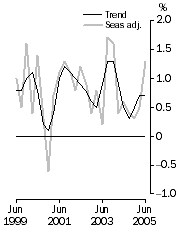
| Contributions to GDP growth, Expenditure - Seasonally adjusted
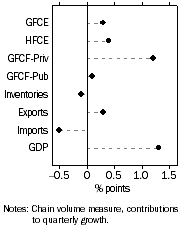
|
JUNE KEY POINTS
VOLUME GDP
- In trend terms, GDP increased 0.7% in the June quarter. GDP per capita grew by 0.4%, GDP per hour worked in the market sector increased by 0.1% and real net national disposable income grew by 1.8%.
- In seasonally adjusted terms, GDP increased by 1.3% in the June quarter. Very strong growth in the terms of trade (up 5.8%) is reflected in strong growth in real net national disposable income of 3.1% in the June quarter.
EXPENDITURE ON GDP
- In seasonally adjusted terms, the increase in expenditure on GDP was driven by contributions from private investment in machinery and equipment (+0.5 percentage points), private investment in non-dwelling construction (+0.4 percentage points) and household final consumption expenditure (+0.4 percentage points). These contributions were partially offset by a negative contribution from net exports (-0.2 percentage points).
INDUSTRY GROSS VALUE ADDED
- The strongest contributions this quarter were from construction (+0.4 percentage points) and property and business services (+0.2 percentage points).
NOTES
FORTHCOMING ISSUES
| ISSUE (QUARTER) | Release Date |
| September 2005 | 7 December 2005 |
| December 2005 | 1 March 2006 |
FEATURE ARTICLES
Three articles are being released with this publication. The abstracts of the articles are presented in this publication while the articles themselves are available on the ABS web site. Directions to the location of the articles are given at the end of each abstract. The three articles 'The relationship between GDP and employment', 'Hours worked estimates in the quarterly national accounts' and 'Forthcoming updated national accounts annual benchmarks' are summarised on pages 13, 14 and 15 respectively.
REVISIONS IN THIS ISSUE
The incorporation of more up-to-date source data has caused revisions to estimates, particularly for the previous seven quarters. Also, a number of components of GDP have been seasonally reanalysed leading to revisions going back around six years in the affected series. The net effect of all revisions to the March quarter 2005 estimate of seasonally adjusted GDP in volume terms has been to decrease quarterly growth by 0.2 percentage points. In addition to these normal quarterly revisions there are a number of other factors influencing the estimates that have led to revisions to both the level and the movement of GDP and its components. First, a new base year, 2003-04, has been introduced into the chain volume estimates which has resulted in revisions to growth rates in subsequent periods. Next, the chain volume estimates have been re-referenced to 2003-04 thus preserving additivity in the quarters after the reference year. Re-referencing affects the levels of, but not the movements in, volume estimates.
CHANGES IN THIS ISSUE
In the March quarter 2005 release of this publication concern regarding the robustness of the seasonal adjustment process for hours worked data led to the suspension of several series while work was undertaken to investigate the data quality issues. This investigation has been completed and updated seasonally adjusted series for hours worked have been re-introduced in this release. The re-introduced series are: Hours worked, Hours worked market sector, GDP per hour worked and GDP per hour worked market sector. These are all presented in Table 2 of the publication. The results of the investigation are summarised on page 14 of this release.
CHANGES IN THE NEXT ISSUE
The September quarter 2005 release of this publication will contain revisions to many series as a result of benchmarking quarterly series to updated annual benchmarks from the annual supply and use tables. These updated benchmarks will be first published in the Australian System of National Accounts (cat. no. 5204.0) to be released on 2 November, 2005. An article outlining the annual changes has been published with this release (see details above). Quarterly revisions will also result from the annual seasonal reanalysis that is undertaken on all series.
INQUIRIES
For further information contact Patricia Mahony on Canberra (02) 6252 6711 for industry and income estimates, and Daniel Smith on Canberra (02) 6252 6713 for consumption, investment and trade estimates.
MAIN FEATURES EXPENDITURE CHAIN VOLUME MEASURES
 |  |  | Trend
| Seasonally adjusted
|  |
 |  |  | Quarterly % change Mar 05 to Jun 05 | Annual % change Jun 04 to Jun 05 | % points contribution to growth in GDP Mar 05 to Jun 05 | Quarterly % change Mar 05 to Jun 05 | Annual % change Jun 04 to Jun 05 | % points contribution to growth in GDP Mar 05 to Jun 05 |  |
|  |
| Final consumption expenditure |  |  |  |  |  |  |  |
 | General government | 0.7 | 2.8 | 0.1 | 1.8 | 3.6 | 0.3 |  |
 | Households | 0.6 | 2.7 | 0.4 | 0.7 | 3.0 | 0.4 |  |
| Gross fixed capital formation |  |  |  |  |  |  |  |
 | Private |  |  |  |  |  |  |  |
 |  | Dwellings | 0.4 | -3.4 | - | 3.3 | -2.0 | 0.2 |  |
 |  | Business investment | 3.0 | 15.3 | 0.4 | 6.8 | 15.3 | 0.9 |  |
 |  | Ownership transfer costs | 1.2 | -8.4 | - | 5.7 | -5.1 | 0.1 |  |
 | Public | 0.8 | 6.5 | - | 1.8 | 8.5 | 0.1 |  |
| Changes in inventories |  |  |  |  |  |  |  |
 | Private non-farm | . . | . . | 0.3 | . . | . . | -0.1 |  |
 | Farm and public authority | . . | . . | - | . . | . . | - |  |
| Gross national expenditure | 1.2 | 4.0 | 1.2 | 1.8 | 4.4 | 1.9 |  |
| Exports of goods and services | 1.3 | 2.8 | 0.2 | 1.6 | 1.9 | 0.3 |  |
| Imports of goods and services | 2.3 | 10.6 | -0.5 | 2.0 | 10.4 | -0.5 |  |
| Statistical discrepancy (E) | . . | . . | -0.1 | . . | . . | -0.4 |  |
| Gross domestic product | 0.7 | 2.3 | 0.7 | 1.3 | 2.6 | 1.3 |  |
|  |
| . . not applicable |
| - nil or rounded to zero (including null cells) |
JUNE QUARTER
Summary Comments
Final Consumption Expenditure
- In trend terms, household consumption increased by 0.6%. Seasonally adjusted growth was 0.7%, driven by hotels, cafes and restaurants up 2.9% and communication up 2.5%. Purchase of vehicles fell by 4.0%. Government consumption grew by 0.7% in trend terms, with national non-defence expenditure the main contributor.
Private gross fixed capital formation (GFCF)
- Trend private GFCF showed continued strength this quarter, up 2.1% (up 5.6% seasonally adjusted). The main drivers this quarter, in seasonally adjusted terms, were new building investment (up 11.5%) and new machinery and equipment investment (up 7.4%). More moderate growth was shown in new engineering construction, up 1.9%, after increases of over 9.0% for the previous two quarters.
Changes in inventories
- Trend inventories increased by $1,168 million (up $1,047 million seasonally adjusted), mainly driven by a build up in retail and wholesale inventories. This rise follows a slightly larger rise in March quarter (seasonally adjusted), thus changes in inventories detracted from seasonally adjusted GDP growth.
Exports and imports of goods and services
- Exports of goods and services rose by 1.3% in trend terms (up 1.6% seasonally adjusted). In seasonally adjusted terms exports of goods rose by 3.2% with the main contributor being non-rural exports (up 2.6%). Exports of services fell by 3.5% seasonally adjusted, with a large decline in travel services.
- Imports of goods and services rose by 2.3% in trend terms (up 2.0% seasonally adjusted). Imports of goods rose 2.9% seasonally adjusted mainly due to strong contributions from imports of intermediate and capital goods. Imports of services fell by 1.5% seasonally adjusted, driven by falls in freight transportation.
MAIN FEATURES PRODUCTION CHAIN VOLUME MEASURES
 | Trend
| Seasonally adjusted
|  |
 | Quarterly % change Mar 05 to Jun 05 | Annual % change Jun 04 to Jun 05 | % points contribution to growth in GDP Mar 05 to Jun 05 | Quarterly % change Mar 05 to Jun 05 | Annual % change Jun 04 to Jun 05 | % points contribution to growth in GDP Mar 05 to Jun 05 |  |
|  |
| Agriculture, forestry and fishing | 1.0 | -4.6 | - | 0.2 | -2.9 | - |  |
| Mining | 0.3 | 4.4 | - | 1.1 | 3.3 | - |  |
| Manufacturing | 0.7 | -0.1 | 0.1 | 1.3 | -0.1 | 0.1 |  |
| Electricity, gas and water supply | 0.9 | 0.4 | - | 0.9 | -0.3 | - |  |
| Construction | 2.2 | 4.3 | 0.1 | 5.9 | 6.6 | 0.4 |  |
| Wholesale trade | 0.8 | 2.0 | - | 1.9 | 2.8 | 0.1 |  |
| Retail trade | 0.1 | 1.9 | - | -0.8 | 1.8 | - |  |
| Accommodation, cafes and restaurants | - | -1.5 | - | 1.5 | -0.8 | - |  |
| Transport and storage | 0.8 | 4.2 | - | - | 4.0 | - |  |
| Communication services | 0.4 | 2.4 | - | 2.4 | 3.6 | 0.1 |  |
| Finance and insurance | 1.5 | 5.9 | 0.1 | 1.9 | 6.1 | 0.2 |  |
| Property and business services | 0.2 | -0.4 | - | 1.7 | 0.8 | 0.2 |  |
| Government administration and defence | 0.4 | 2.9 | - | 0.5 | 3.2 | - |  |
| Education | 0.3 | 1.2 | - | 0.3 | 1.3 | - |  |
| Health and community services | -0.1 | 3.0 | - | 0.3 | 3.0 | - |  |
| Cultural and recreational services | 1.1 | 6.3 | - | 2.8 | 8.2 | 0.1 |  |
| Personal and other services | 0.7 | 1.4 | - | 0.6 | 1.0 | - |  |
| Ownership of dwellings | 1.0 | 4.3 | 0.1 | 1.0 | 4.3 | 0.1 |  |
| Taxes less subsidies on products | -0.2 | 1.6 | - | - | 2.1 | - |  |
| Statistical discrepancy (P) | . . | . . | 0.1 | . . | . . | - |  |
| Gross domestic product | 0.7 | 2.3 | 0.7 | 1.3 | 2.6 | 1.3 |  |
|  |
| . . not applicable |
| - nil or rounded to zero (including null cells) |
JUNE QUARTER
Summary Comments
Agriculture, Forestry and Fishing
- The trend estimate increased by 1.0% and the seasonally adjusted estimate by 0.2%. A fall in cereal grain production was more than offset by increased production of non-cereal crops and wool and increased livestock slaughterings.
Manufacturing
- Increased by 0.7% in trend terms and by 1.3% in seasonally adjusted terms. Growth was driven by contributions from the food, beverage and tobacco industry and the non-metallic mineral products industry.
Construction
- The trend estimate grew by 2.2% and the seasonally adjusted estimate was 5.9% higher. There was strong activity in both the house building sector and the non-residential building sector.
Property and business services
- Increased by 0.2% in trend terms and 1.7% in seasonally adjusted terms. The seasonally adjusted increase was mainly due to a surge in property sales.
Wholesale and Retail Trade
- Wholesale trade rose by 0.8% in trend terms and by 1.9% in seasonally adjusted terms, while retail trade increased by 0.1% in trend terms but fell by 0.8% in seasonally adjusted terms. For wholesale trade the main contributor to the growth was strong sales of personal and household goods. For the retail industry the seasonally adjusted result mainly reflects a 1.5% fall in motor vehicle retailing and services.
MAIN FEATURES INCOME AT CURRENT PRICES
 |  | Trend
| Seasonally adjusted
|  |
 |  | Quarterly % change Mar 05 to Jun 05 | Annual % change Jun 04 to Jun 05 | % points contribution to growth in GDP Mar 05 to Jun 05 | Quarterly % change Mar 05 to Jun 05 | Annual % change Jun 04 to Jun 05 | % points contribution to growth in GDP Mar 05 to Jun 05 |  |
|  |
| Compensation of employees | 1.9 | 7.3 | 0.9 | 2.1 | 7.4 | 1.0 |  |
| Gross operating surplus |  |  |  |  |  |  |  |
 | Private | 3.8 | 10.4 | 0.7 | 7.4 | 10.4 | 1.3 |  |
 | Other | 1.5 | 6.4 | 0.2 | 0.6 | 5.8 | 0.1 |  |
| Gross mixed income | -0.2 | 0.1 | - | 0.5 | 1.4 | - |  |
| Taxes less subsidies on production and imports | 0.2 | 3.2 | - | 0.2 | 5.7 | - |  |
| Statistical discrepancy (I) | . . | . . | 0.1 | . . | . . | 0.4 |  |
| Gross domestic product | 2.0 | 6.8 | 2.0 | 2.9 | 7.3 | 2.9 |  |
|  |
| . . not applicable |
| - nil or rounded to zero (including null cells) |
JUNE QUARTER
Summary Comments
Compensation of employees
- The trend increase of 1.9% in the June quarter reflects a rise of 0.9% in average earnings and a 1.0% rise in the number of wage and salary earners. Seasonally adjusted, compensation of employees grew by 2.1%. Average earnings increased by 1.1%, while the number of wage and salary earners increased by 1.0%. Further discussion of compensation of employees is found on pages 10 and 11.
Wages(a) share of total factor income: Trend
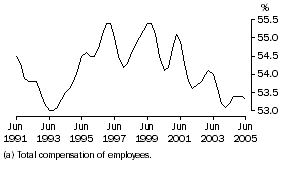
Gross operating surplus (GOS)
- The trend GOS of financial and non-financial corporations increased by 3.0% in the June quarter. Seasonally adjusted, GOS of financial and non-financial corporations increased by 5.2%, following an increase of 1.9% in the March quarter
Profit(a) share of total factor income: Trend
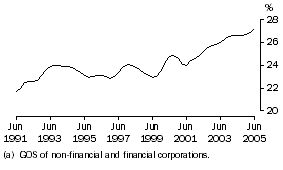
MAIN FEATURES STATE FINAL DEMAND CHAIN VOLUME MEASURES
 | Trend
| Seasonally adjusted
|  |
 | Quarterly % change Mar 05 to Jun 05 | Annual % change Jun 04 to Jun 05 | % points contribution to growth in DFD Mar 05 to Jun 05 | Quarterly % change Mar 05 to Jun 05 | Annual % change Jun 04 to Jun 05 | % points contribution to growth in DFD Mar 05 to Jun 05 |  |
|  |
| New South Wales | 0.8 | 3.0 | 0.3 | 1.5 | 3.3 | 0.5 |  |
| Victoria | 0.9 | 3.6 | 0.2 | 2.4 | 4.8 | 0.6 |  |
| Queensland | 0.8 | 3.9 | 0.2 | 2.2 | 4.8 | 0.4 |  |
| South Australia | 0.9 | 3.6 | 0.1 | 2.0 | 3.9 | 0.1 |  |
| Western Australia | 1.4 | 5.7 | 0.1 | 2.0 | 5.3 | 0.2 |  |
| Tasmania | 0.3 | 4.1 | - | 0.9 | 4.9 | - |  |
| Northern Territory | 5.2 | 12.6 | 0.1 | 8.3 | 14.4 | 0.1 |  |
| Australian Capital Territory | - | 1.3 | - | 1.0 | 1.8 | - |  |
| Australia (DFD)(a) | 1.0 | 3.8 | 1.0 | 1.9 | 4.3 | 1.9 |  |
|  |
| - nil or rounded to zero (including null cells) |
| (a) Domestic final demand. |
JUNE QUARTER
Summary Comments
State Final Demand
- In trend terms growth in the June quarter was strongest in the Northern Territory (up 5.2%), with moderate increases in all other states except the Australian Capital Territory. In seasonally adjusted terms Northern Territory (up 8.3%) showed the strongest growth with the major contributor being private gross fixed capital formation. Seasonally adjusted growth was weakest in Tasmania (up 0.9%) due predominantly to a fall in public gross fixed capital formation.
Household final consumption expenditure
- In trend terms, all states experienced growth, ranging from 1.3% in Northern Territory to 0.3% in New South Wales. Growth in seasonally adjusted terms was also recorded in all states with Northern Territory the highest (up 2.4%).
Government final consumption expenditure
- Trend growth in the June quarter was strongest in Northern Territory (up 1.1%) while the weakest growth was recorded in New South Wales and Queensland (each up 0.2%). In seasonally adjusted terms strongest growth occurred in Northern Territory (up 3.7%) with Tasmania recording weakest growth (down 0.2%).
Private gross fixed capital formation
- In trend terms, the strongest growth was recorded in Northern Territory, up 15.4%. Trend growth was lowest in Tasmania, where no growth was recorded between March and June quarters. In seasonally adjusted terms weakest growth was recorded in Western Australia (down 2.0%).
- Investment in machinery and equipment increased in all states, in seasonally adjusted terms, except Western Australia (down 7.0%). Strongest growth was recorded in Northern Territory (up 44.4%). Strongest growth in seasonally adjusted non-dwelling construction occurred in New South Wales (up 23.4%) with weakest growth recorded in Western Australia (down 4.5%). Strong dwelling investment (seasonally adjusted) growth was recorded in South Australia (up 9.5%) and Victoria (up 9.1%), while Tasmania had the largest fall (down 7.7%).
Public gross fixed capital formation
- Growth in trend terms varied across the states. In seasonally adjusted terms, strong growth was recorded in Northern Territory (up 48.2%) and Western Australia (30.2%), whereas the Australian Capital Territory had the largest fall (down 26.6%).
ANALYSIS AND COMMENTS
GROWTH RATES IN GDP
The graph below provides a comparison of the quarterly growth rates for volume measures of GDP in both seasonally adjusted and trend terms over the last fourteen years. Following the fall in GDP (in seasonally adjusted volume terms) in December quarter 2000 there have been 18 consecutive quarters of growth.
Percentage changes, Chain volume measures
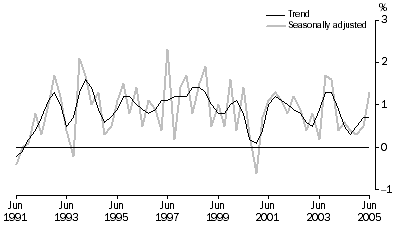
Growth (in trend volume terms) over the past four quarters has been driven by private investment in machinery and equipment (up 17.5%), new engineering construction (up 19.8%) and household final consumption expenditure (up 2.7%). Offsetting these was a strong rise in imports of goods and services (up 10.6%) and a fall in dwelling investment (down 3.4%).
On the industry side, the strongest contributors (in trend volume terms) over the past four quarters have been finance and insurance (up 5.9%), construction (up 4.3%) and transport and storage (up 4.2%). Detracting from growth was a fall in agriculture, forestry and fishing (down 4.6%) and small declines in the two largest industries property and business services (down 0.4%) and manufacturing (down 0.1%).
REAL GROSS DOMESTIC INCOME
A measure of the real purchasing power of income generated by domestic production is the chain volume measure of GDP adjusted for the terms of trade effect, which is referred to as real gross domestic income (see Glossary for definition). The graph below provides a comparison of quarterly movements in trend GDP (volume measure) and real gross domestic income. During the June quarter, trend real gross domestic income increased by 1.4%, compared to the increase in the trend volume measure of GDP of 0.7%, reflecting a 6.2% improvement in the terms of trade. Trend and seasonally adjusted estimates of real gross domestic income are shown in tables 1 and 2.
Percentage changes, Trend
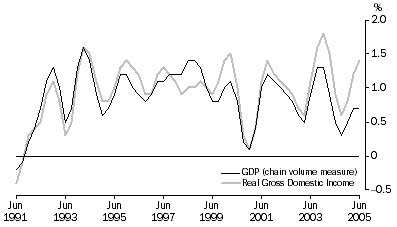
TERMS OF TRADE
The graph below shows the trend terms of trade (see Glossary for definition) over the past fourteen years. The very strong growth (up 24.9%) in the terms of trade since March quarter 2003 reflects a 10.7% growth in export prices and an 11.3% fall in import prices over the period. In June quarter 2005 the terms of trade rose 6.2% in trend terms, driven by a 5.8% rise in export prices.
Trend, (2003-04 = 100)
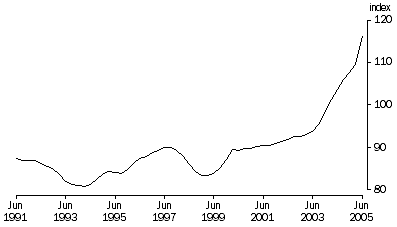
REAL NET NATIONAL DISPOSABLE INCOME
A broader measure of change in national economic well-being is real net national disposable income. This measure adjusts the volume measure of GDP for the terms of trade effect, real net incomes from overseas and consumption of fixed capital (see Glossary for definition). The graph below provides a comparison of quarterly movements in trend GDP (volume measure) and real net national disposable income. During the June quarter, trend real net national disposable income increased by 1.8%, while the increase in the trend volume measure of GDP was 0.7%.
Percentage changes, Trend
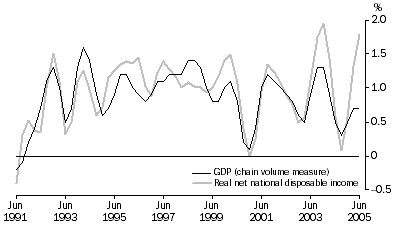
HOUSEHOLD SAVING RATIO
In both trend and seasonally adjusted terms the household saving ratio (see Glossary for definition) was negative in June quarter 2005, implying that household consumption was greater than household disposable income. In trend terms the ratio was -2.9% in June quarter 2005 and in seasonally adjusted terms it was -2.8%. The following graph presents the household saving ratio derived from trend and seasonally adjusted data.
Household saving ratio, Current prices
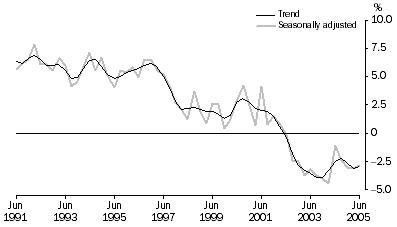
Although seasonally adjusted household saving has been negative over the past three years, net national saving has been positive over the same period. The net national saving ratio in the June quarter 2005 was 5.5% in seasonally adjusted terms.
Caution should be exercised in interpreting the household saving ratio in recent years, because major components of household income and expenditure may still be subject to significant revisions. The impact of these revisions on the saving ratio can cause changes in the apparent direction of the trend.
COMPENSATION OF EMPLOYEES
In June quarter 2005, seasonally adjusted compensation of employees grew by 2.1%, while the seasonally adjusted number of employees recorded in the Labour Force survey grew by 1.0%. Thus, average compensation per employee increased by 1.1%. This follows growth of 0.7% and 0.9% in the December quarter 2004 and March quarter 2005 respectively. The annual 2004-05 growth rate was 3.6% compared to 3.8% growth over the same period in the total hourly rates of pay, excluding bonuses as published in Labour Price Index, Australia (cat. no. 6345.0). (It should be noted that the conceptual bases for the two wage measures are different.)
PRIVATE NON-FARM INVENTORIES TO TOTAL SALES RATIO
In trend current price terms, the book value of private non-farm inventories increased by $1,295 million (1.2%) in June quarter 2005, while total sales rose by $3,204 million (2.4%). Consequently, the trend inventories to total sales ratio (see Glossary for definition) decreased from 0.782 in the March quarter 2005 to 0.773 in June quarter 2005. The following graph presents the ratio of private non-farm inventories to total sales over the last fourteen years.
Trend, Current prices
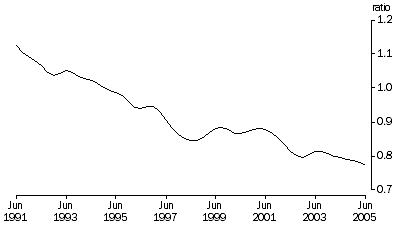
IMPORTS TO DOMESTIC SALES
The imports to domestic sales ratio (see Glossary for definition), trended and at current prices, showed a minor increase to 0.364. This reflects a rise of 2.0% in imports of goods accompanied by a 1.6% rise in domestic sales. The following graph presents the ratio of imports to domestic sales over the last fourteen years.
Trend, Current prices
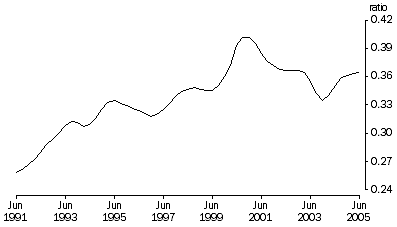
RELIABILITY OF CONTEMPORARY TREND ESTIMATES
Trend estimates are used throughout this publication as an alternative approach to the analysis of movements in time series data. Further details regarding the procedures used to estimate the trend series are described in the Explanatory Notes (paragraphs 13 - 17) and in Information Paper: A Guide to Interpreting Time Series - Monitoring Trends, 2003 (cat. no. 1349.0) released in August 2003.
Potential revisions to trend estimates can be indicated by showing the effects of particular changes in seasonally adjusted estimates that might occur in the next quarter. The table below shows the trend estimates for the last ten quarters and the values to which they would be revised if the given movements in seasonally adjusted GDP actually occurred in September quarter 2005. Seasonally adjusted growth of 0.3% is required in September quarter 2005 to maintain, in September quarter 2005, the trend growth of 0.7% currently estimated for the June quarter 2005.
Percentage change in GDP Chain volume measure |
|  |
 |  |  |  | Trend estimate if seasonally adjusted GDP changes by the following amounts in September qtr 2005
|  |
 |  | Seasonally adjusted GDP as published in table 2 | Trend GDP as published in table 1 | Grows by 1.0% | No change | Falls by 1.0% |  |
|  |
| 2003 |  |  |  |  |  |  |
 | March | 0.8 | 0.5 | 0.5 | 0.5 | 0.5 |  |
 | June | 0.2 | 0.9 | 0.9 | 0.9 | 0.9 |  |
 | September | 1.7 | 1.3 | 1.3 | 1.3 | 1.3 |  |
 | December | 1.6 | 1.3 | 1.3 | 1.3 | 1.3 |  |
| 2004 |  |  |  |  |  |  |
 | March | 0.4 | 0.9 | 0.9 | 0.9 | 0.9 |  |
 | June | 0.6 | 0.5 | 0.5 | 0.5 | 0.5 |  |
 | September | 0.4 | 0.3 | 0.3 | 0.3 | 0.3 |  |
 | December | 0.3 | 0.5 | 0.4 | 0.5 | 0.6 |  |
| 2005 |  |  |  |  |  |  |
 | March | 0.5 | 0.7 | 0.7 | 0.6 | 0.6 |  |
 | June | 1.3 | 0.7 | 0.9 | 0.7 | 0.4 |  |
|  |
 Print Page
Print Page
 Print All
Print All